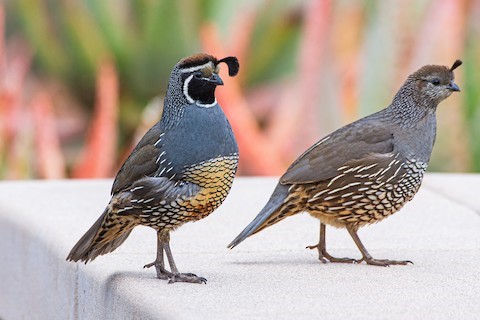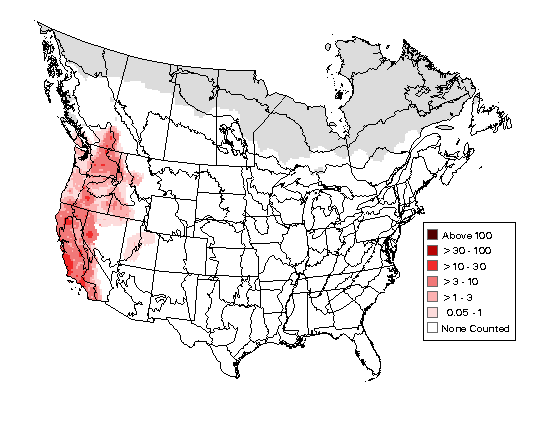Birdfinding.info ⇒ Common to locally abundant throughout most of its range, especially along the Pacific Coast of North America from Vancouver Island to San Diego, in northern Great Basin valleys from the Okanagan to Reno and Boise, in the chaparral region of central Chile, and much of New Zealand. (See Breeding Bird Survey Abundance Map in Notes, below.)
California Quail
Callipepla californica
Family: Odontophoridae
Western North America; widely introduced elsewhere. Inhabits open woodlands and various mixed, brushy, and scrubby habitats, including settled and agricultural areas.
Natural range includes the Pacific lowlands and foothills from southwestern British Columbia south to the tip of Baja California, and interior valleys north into central British Columbia and east to western Montana, northwestern Colorado, and southeastern Utah.
Introduced populations are established in Chile (Coquimbo to Gral Carrera) and adjacent portions of Argentina (Mendoza to Chubut), New Zealand (North and South Islands), Australia’s King and Norfolk Islands, Corsica, and on three of the main Hawaiian Islands: Molokai, Maui, and the Big Island. Due to its popularity with hunting groups and abundance in captivity, smaller introduced populations may appear from time to time nearly anywhere.
Identification
A plump gray-and-brown quail with a prominent topknot, very similar to its sibling species, the Gambel’s Quail (see below).
Shows significant regional variation in plumage—mainly in the tones of its upperparts, which range from lead-gray to sandy-brown, and to some extent in its belly pattern and coloration.
The male is boldly patterned: brown crown and black face and throat bordered by crisp white lines, and densely speckled or scaled pattern on the neck.
The topknot consists of one or two black feathers jutting decoratively from the forehead like plumes on a fancy hat.
The belly has a strong scaled pattern that progresses from predominantly white to buffy to chestnut in the center. The sides are brown with prominent white streaks.
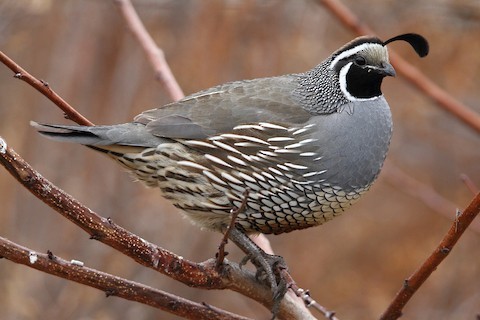
California Quail, male. (Summitview, Washington; December 11, 2017.) © James Cummins
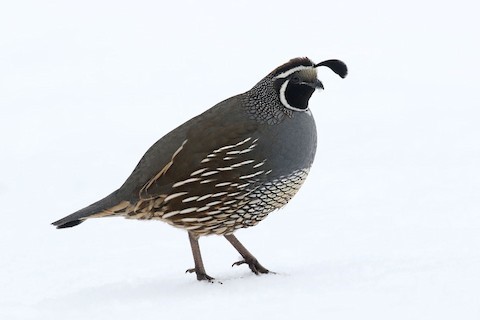
California Quail, male. (Pleasant Hill, Oregon; February 27, 2019.) © Noah Strycker
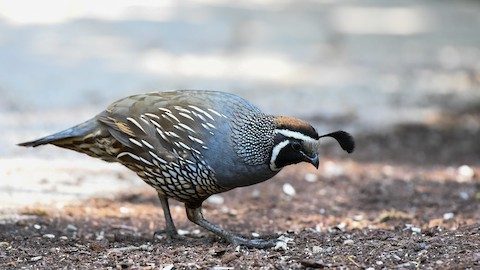
California Quail, male showing bluish-gray upperparts. (View Royal, British Columbia; July 6, 2019.) © Randy Walker
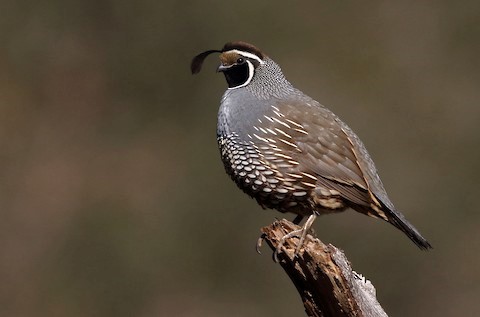
California Quail, male. (Ancil Hoffman Park, Carmichael, California; January 13, 2017.) © Andrew Johnson

California Quail, male with gray upperparts. (Penticton, British Columbia; June 13, 2018.) © Kalin Ocaña
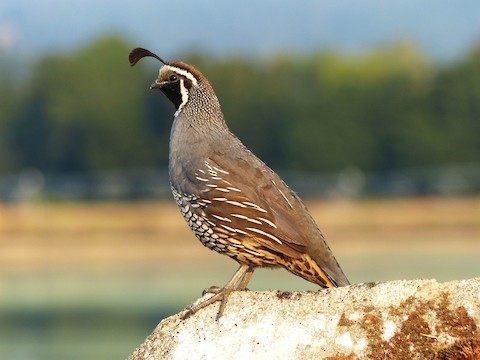
California Quail, male with mostly brownish upperparts. (Philomath Sewage Ponds, Benton County, Oregon; September 3, 2017.) © Hendrik Herlyn

California Quail, male with mixed brown and gray upperparts. (Penticton, British Columbia; April 19, 2020.) © Alex Bodden
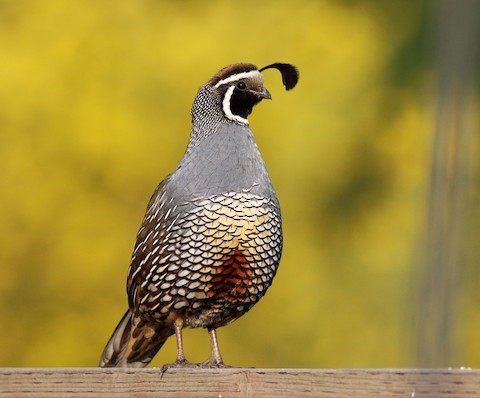
California Quail, male. (Carmel Valley, California; April 9, 2017.) © Paul Fenwick
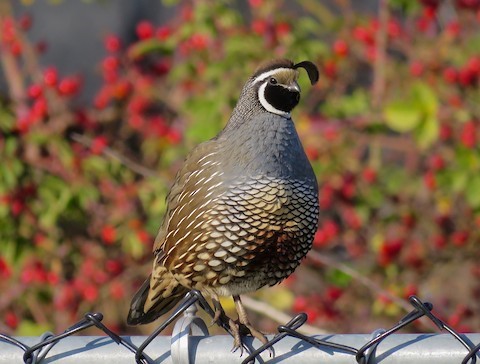
California Quail, male. (Kelowna, British Columbia; November 18, 2018.) © Nick Swan
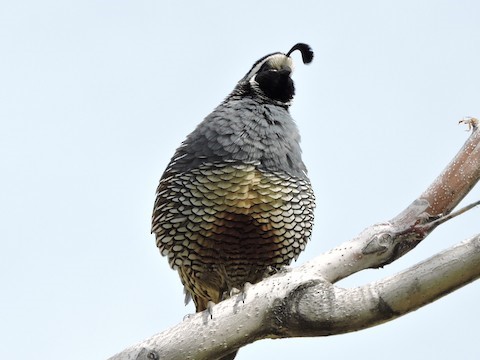
California Quail, male. (City Creek Canyon, Salt Lake City, Utah; May 2, 2014.) © Max Malmquist

California Quail, male. (Rose Valley Regional Park, Kelowna, British Columbia; May 20, 2019.) © Kalin Ocaña

California Quail, male. (Penticton, British Columbia; April 19, 2020.) © Alex Bodden

California Quail, male. (Carmel Valley, California; April 9, 2017.) © Paul Fenwick
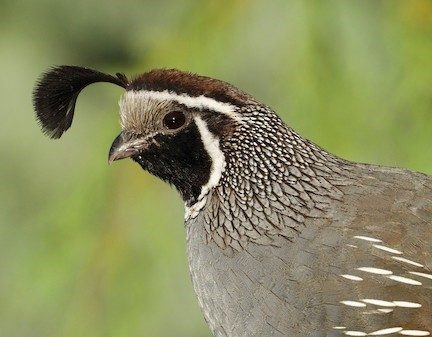
California Quail, male. (West Kelowna, British Columbia; August 4, 2020.) © Kalin Ocaña
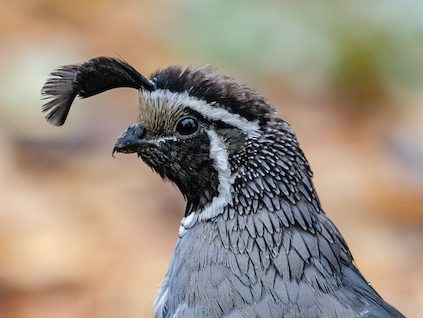
California Quail, male. (University of Idaho Arboretum and Botanical Gardens, Moscow, Idaho; September 28, 2019.) © Mason Maron
Female is similar to the male overall but much plainer and browner, lacking the bold head pattern and chestnut belly patch.
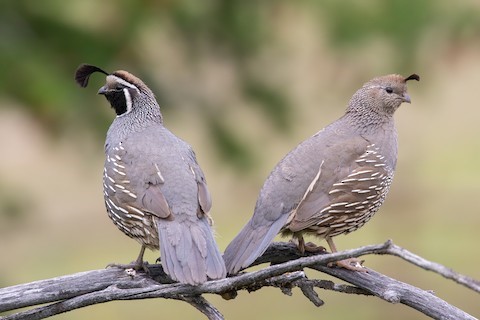
California Quail, male and female, both with brownish-gray upperparts. (Kruger Mountain Road, Osoyoos, British Columbia; June 21, 2020.) © Blair Dudeck
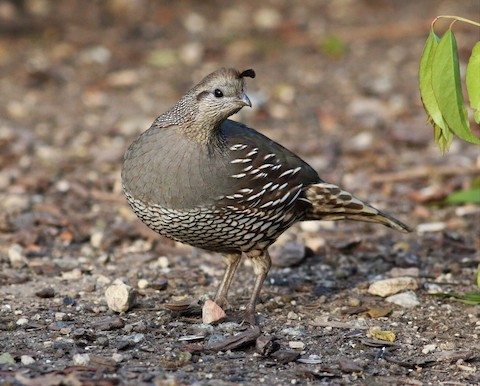
California Quail, female with brownish-gray upperparts. (Carmel Valley, California; April 9, 2017.) © Paul Fenwick
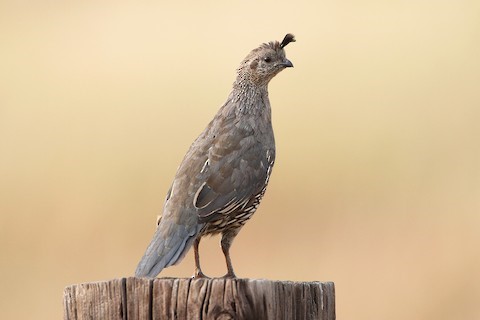
California Quail, female with mixed brown and gray upperparts. (Mead, Washington; September 8, 2017.) © Marlene Cashen
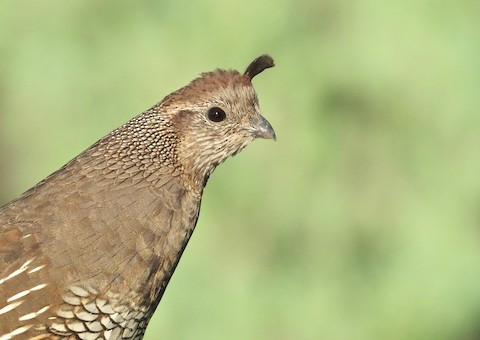
California Quail, female with brown upperparts. (West Kelowna, British Columbia; August 4, 2020.) © Kalin Ocaña
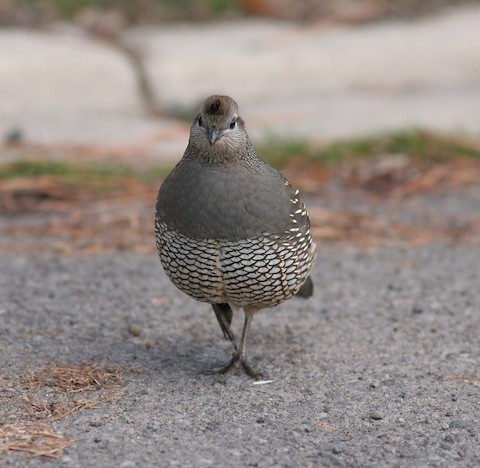
California Quail, female showing bold scaled pattern on belly. (Klamath Falls, Oregon; February 28, 2017.) © Matthew Bowman
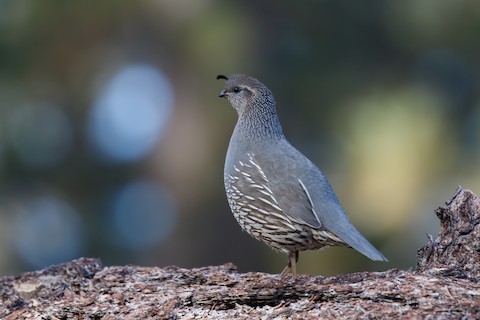
Gambel’s Quail, female. (Union Tract, Salton Sea National Wildlife Refuge, California; March 1, 2019.) © Andrew Simon
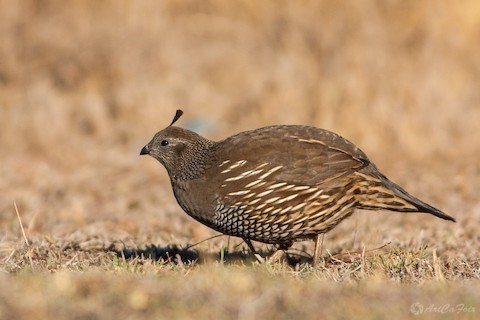
California Quail, female with brown upperparts. (Universidad de Chile – South Campus, La Pintana, Chile; April 11, 2017.) © Ariel Cabrera Foix
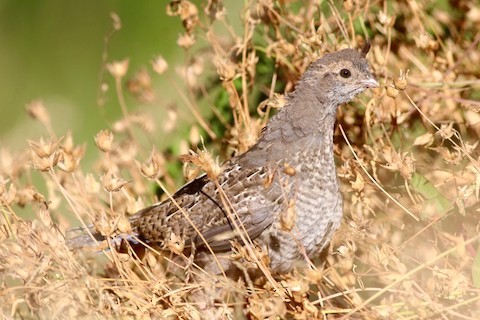
California Quail, juvenile. (Palo Comado Canyon, Ventura County, California; July 4, 2020.) © Cameron Tescher
Cf. Gambel’s Quail. California and Gambel’s Quails are closely related and bear an obvious resemblance. Their ranges overlap marginally from Utah to Baja California, and in these areas they have been known to interbreed. Males differ conspicuously in their belly patterns: mostly solid patches of whitish or yellowish and black on Gambel’s versus heavy scaling on California.
The females resemble one another more because their coloration is muted and female Gambel’s typically shows a textured pattern on the belly—not as clearly scaled as female California, but it can be similar. A consistent feature of Gambel’s is the chestnut coloration on the sides, which California lacks.
Cf. Scaled Quail. Female California Quail resembles both sexes of Scaled Quail. Their natural ranges do not overlap, so confusion is rare, but California has been introduced locally east of its established range. The main differences are the crest or topknot (black on California, white on Scaled) and the pattern on the breast (strongly scaled on Scaled, mostly unmarked on California).
Notes
Polytypic species consisting of eight recognized subspecies.
References
Alderfer, J., and J.L. Dunn. 2014. National Geographic Complete Birds of North America (Second Edition). National Geographic Society, Washington, D.C.
BirdLife International. 2018. Callipepla californica. The IUCN Red List of Threatened Species 2018: e.T22679603A131906420. https://dx.doi.org/10.2305/IUCN.UK.2018-2.RLTS.T22679603A131906420.en. (Accessed August 26, 2020.)
eBird. 2020. eBird: An online database of bird distribution and abundance. Cornell Lab of Ornithology, Ithaca, N.Y. http://www.ebird.org. (Accessed August 26, 2020.)
Howell, S.N.G., and S. Webb. 1995. A Guide to the Birds of Mexico and Northern Central America. Oxford University Press.
Madge, S., and P.J.K. McGowan. 2002. Pheasants, Partridges, and Grouse: A Guide to the Pheasants, Partridges, Quails, Grouse, Guineafowl, Buttonquails, and Sandgrouse of the World. Princeton University Press, Princeton, N.J.
Mullarney, K., L. Svensson, D. Zetterström, and P.J. Grant. 1999. Birds of Europe. Princeton University Press, Princeton, N.J.
Pyle, R.L., and P. Pyle. 2017. The Birds of the Hawaiian Islands: Occurrence, History, Distribution, and Status. Version 2 (January 1, 2017). http://hbs.bishopmuseum.org/birds/rlp-monograph/. B.P. Bishop Museum, Honolulu, Hawaii.
Sibley, D.A. 2000. The Sibley Guide to Birds. Alfred A. Knopf. New York.
Xeno-Canto. 2020. California Quail – Callipepla californica. https://www.xeno-canto.org/species/Callipepla-californica. (Accessed August 26, 2020.)
